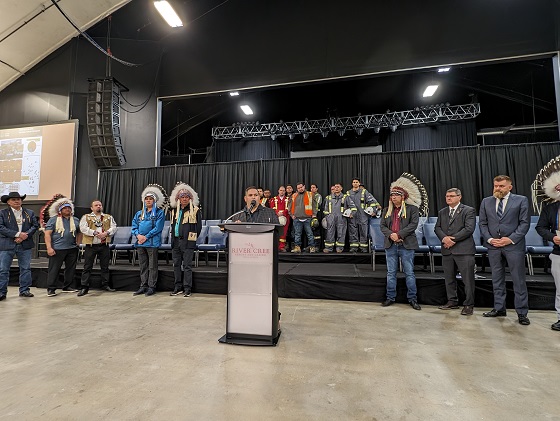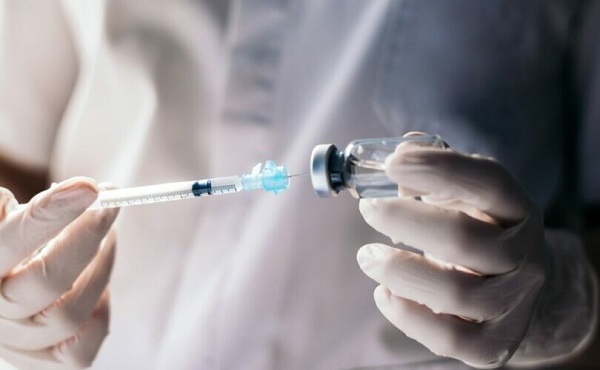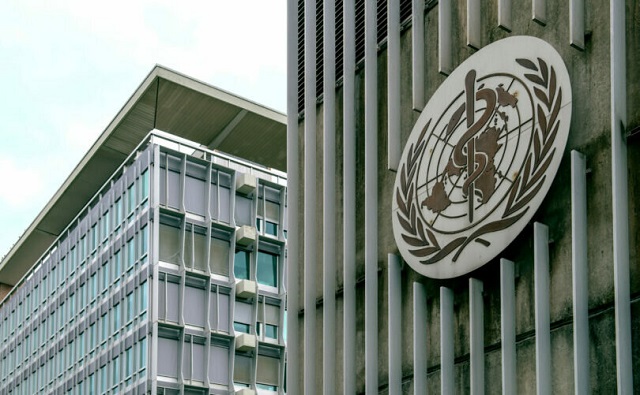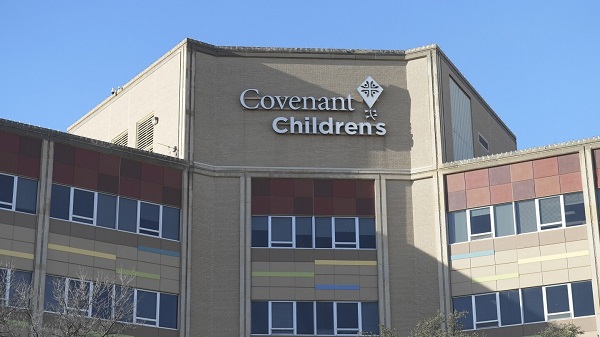Alberta
Alberta Chiefs demand Ottawa return funding for orphan well clean up

News release from Dennis Burnside, VP & Indigenous Practice Lead, Political Intelligence
Alberta Chiefs and the IRC call on Federal Government to fulfill its environmental obligations and commitments by releasing funding to First Nations
Government of Canada seeking to return $135 million in previously committed funding to federal coffers to use as savings, instead of empowering First Nations to clean up inactive and orphan wells on their lands.
ENOCH CREE NATION, AB, March 11, 2024
Chief Cody Thomas, Enoch Cree Nation, Chief Roy Whitney, Tsuut’ina Nation, and Chief Ivan Sawan, Loon River First Nation, joined with Chiefs from across Alberta today to call on the Federal Government to release unspent funding committed to the Site Rehabilitation Program (SRP) – approximately $135 million –to be utilized by Indigenous people to reclaim additional inactive and orphan wells on their lands. These funds are still in Alberta, but Ottawa is demanding them back.
On December 12, 2023, Chiefs from Treaty 6, Treaty 7, and Treaty 8 territories wrote to Minister Jonathan Wilkinson appealing to the federal government to allow the government of Alberta to place unspent SRP monies into the FNSR Program, providing much needed funding to continue the successful work that has been accomplished by First Nations, for First Nations. Without these funds, governments and industry would be leaving over 2,000 sites to be abandoned or reclaimed on First Nations lands and territories.
Chief Thomas stated: “We still have many inactive wells on our lands that need to be reclaimed properly; we estimate nearly 2,000 sites which will cost over $225 million. We acknowledge the work that has been done under the SRP but there is more to be done. This is a liability of the lessees, and the Alberta Government is holding them accountable through the Well Closure Program. However, time is not on our side. We have a very limited land base and a growing population. We must do the necessary land stewardship immediately”.
Chief Ivan Sawan stated: “Many Alberta First Nations have felt the greatest impacts of natural resource developments which have swept through our lands and ancestral territories for generations, leaving behind environmental wreckage, while being deprived of the opportunity to meaningfully participate or benefit. We are calling on the federal government to do the right thing and release these funds for the environmental and economic purposes they were intended, so that First Nations can create meaningful job opportunities, clean up our lands, and create a healthier and more prosperous future for our people.”
Chief Roy Whitney stated: “Too many oil and gas companies have simply walked away from their obligation to remediate their well sites on First Nation Lands. The SRP was a way for First Nations to have abandoned sites reclaimed. Accordingly, it was with great disappointment when we learned that the Federal Government was not going to release the remaining funds for the SRP. We fully support the request for the remaining funds being held to be released to continue the work to clean up our Lands.”
Under the previous Alberta Site Rehabilitation Program (ASRP) $130 million was allocated to 32 Alberta First Nations and Metis communities to clean up 2,145 sites. First Nations were able to abandon 988 wells and 411 km of pipelines as well as complete 793 reclamations while working on 4,188 projects. The result was a reduction of over $123 million in liability on reserves in Alberta while creating jobs, business development and training, and improving Indigenous community engagement and capacity.
The Indian Resource Council, an advocacy group that negotiated the set aside funding for First Nations, has detailed data on inactive and orphan wells on Indigenous lands. Stephen Buffalo, President and CEO of the IRC stated that the Federal regulator, IOGC, dropped the ball by failing to hold companies liable for their liabilities. He stated that First Nations can no longer depend on IOGC to get this work done.
Mr. Buffalo added: “Under Alberta’s SRP program, the government allocated more than $130 million for cleanup projects for First Nations and the Metis. So, we are doing what we can to keep that program going to maintain the success of the initial FNSRP. About 350 community members received jobs and skills training. By removing the aging wells and pipelines we can free up land to use for housing and other purposes” This is why we need the surplus funds.

A sign, from Alberta’s Orphan Well Association (OWA), identifies a non-producing and abandoned oil well near Carseland, Alberta on Sunday, July 21, 2019. Orphan wells do not have parties responsible for decommissioning or reclamation activities. THE CANADIAN PRESS IMAGES/Larry MacDougal
When SRP funding was earmarked to support Indigenous-led projects in 2021, it was celebrated that this was an area where the federal and provincial governments were in “perfect alignment”. This spirit of collaboration was good news for the environment, for Canada’s fight against climate change, and for First Nations. Alberta Chiefs are continuing to call on the federal government to rekindle this spirit of collaboration, however, Minister Wilkinson has recently stated that the federal government has “no plans to provide additional funding for the clean-
up of inactive and orphan wells.”
Alberta
Made in Alberta! Province makes it easier to support local products with Buy Local program

Show your Alberta side. Buy Local. |
When the going gets tough, Albertans stick together. That’s why Alberta’s government is launching a new campaign to benefit hard-working Albertans.
Global uncertainty is threatening the livelihoods of hard-working Alberta farmers, ranchers, processors and their families. The ‘Buy Local’ campaign, recently launched by Alberta’s government, encourages consumers to eat, drink and buy local to show our unified support for the province’s agriculture and food industry.
The government’s ‘Buy Local’ campaign encourages consumers to buy products from Alberta’s hard-working farmers, ranchers and food processors that produce safe, nutritious food for Albertans, Canadians and the world.
“It’s time to let these hard-working Albertans know we have their back. Now, more than ever, we need to shop local and buy made-in-Alberta products. The next time you are grocery shopping or go out for dinner or a drink with your friends or family, support local to demonstrate your Alberta pride. We are pleased tariffs don’t impact the ag industry right now and will keep advocating for our ag industry.”
Alberta’s government supports consumer choice. We are providing tools to help folks easily identify Alberta- and Canadian-made foods and products. Choosing local products keeps Albertans’ hard-earned dollars in our province. Whether it is farm-fresh vegetables, potatoes, honey, craft beer, frozen food or our world-renowned beef, Alberta has an abundance of fresh foods produced right on our doorstep.
Quick facts
- This summer, Albertans can support local at more than 150 farmers’ markets across the province and meet the folks who make, bake and grow our food.
- In March 2023, the Alberta government launched the ‘Made in Alberta’ voluntary food and beverage labelling program to support local agriculture and food sectors.
- Through direct connections with processors, the program has created the momentum to continue expanding consumer awareness about the ‘Made in Alberta’ label to help shoppers quickly identify foods and beverages produced in our province.
- Made in Alberta product catalogue website
Related information
Alberta
Province to expand services provided by Alberta Sheriffs: New policing option for municipalities

Expanding municipal police service options |
Proposed amendments would help ensure Alberta’s evolving public safety needs are met while also giving municipalities more options for local policing.
As first announced with the introduction of the Public Safety Statutes Amendment Act, 2024, Alberta’s government is considering creating a new independent agency police service to assume the police-like duties currently performed by Alberta Sheriffs. If passed, Bill 49 would lay additional groundwork for the new police service.
Proposed amendments to the Police Act recognize the unique challenges faced by different communities and seek to empower local governments to adopt strategies that effectively respond to their specific safety concerns, enhancing overall public safety across the province.
If passed, Bill 49 would specify that the new agency would be a Crown corporation with an independent board of directors to oversee its day-to-day operations. The new agency would be operationally independent from the government, consistent with all police services in Alberta. Unlike the Alberta Sheriffs, officers in the new police service would be directly employed by the police service rather than by the government.
“With this bill, we are taking the necessary steps to address the unique public safety concerns in communities across Alberta. As we work towards creating an independent agency police service, we are providing an essential component of Alberta’s police framework for years to come. Our aim is for the new agency is to ensure that Albertans are safe in their communities and receive the best possible service when they need it most.”
Additional amendments would allow municipalities to select the new agency as their local police service once it becomes fully operational and the necessary standards, capacity and frameworks are in place. Alberta’s government is committed to ensuring the new agency works collaboratively with all police services to meet the province’s evolving public safety needs and improve law enforcement response times, particularly in rural communities. While the RCMP would remain the official provincial police service, municipalities would have a new option for their local policing needs.
Once established, the agency would strengthen Alberta’s existing policing model and complement the province’s current police services, which include the RCMP, Indigenous police services and municipal police. It would help fill gaps and ensure law enforcement resources are deployed efficiently across the province.
Related information
-

 2025 Federal Election2 days ago
2025 Federal Election2 days agoRCMP Whistleblowers Accuse Members of Mark Carney’s Inner Circle of Security Breaches and Surveillance
-

 Also Interesting2 days ago
Also Interesting2 days agoBetFury Review: Is It the Best Crypto Casino?
-

 Autism2 days ago
Autism2 days agoRFK Jr. Exposes a Chilling New Autism Reality
-

 COVID-192 days ago
COVID-192 days agoCanadian student denied religious exemption for COVID jab takes tech school to court
-

 2025 Federal Election2 days ago
2025 Federal Election2 days agoBureau Exclusive: Chinese Election Interference Network Tied to Senate Breach Investigation
-

 International2 days ago
International2 days agoUK Supreme Court rules ‘woman’ means biological female
-

 2025 Federal Election2 days ago
2025 Federal Election2 days agoNeil Young + Carney / Freedom Bros
-

 Health2 days ago
Health2 days agoWHO member states agree on draft of ‘pandemic treaty’ that could be adopted in May






